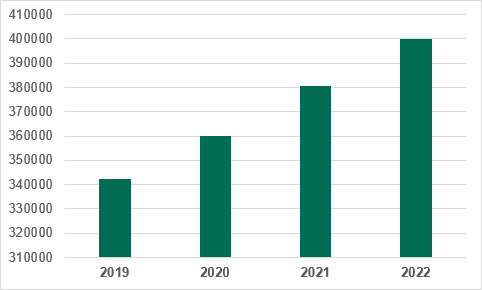In 2022, Kaspersky’s detection systems discovered on average 400,000 malicious files distributed every day, indicating a 5% growth compared to 2021.
The number of certain types of threats also escalated: for example, Kaspersky experts discovered the 181% increase in the proportion of ransomware detected daily.
These and other findings are part of Kaspersky Security Bulletin (KSB) – an annual series of predictions and analytical reports on key shifts within the cybersecurity world.
Kaspersky’s detection systems discovered an average of 403,000 new malicious files daily between January and October 2022. By comparison, about 380,000 of these files were detected every day in 2021, demonstrating a 5% jump. In total, Kaspersky’s systems detected approximately 122 million malicious files in 2022, 6 million more than in 2021.

Kaspersky’s researchers discovered that the share of ransomware encountered daily increased by 181% compared to 2021, reaching 9,500 encrypting files per day.
Among other threats, Kaspersky security solutions also detected the 142% growth in the share of Downloaders – malicious programs that install new versions of malware or unwanted applications on infected devices.
Windows continued to be the prime target of attacks among all platforms where threat families were spread. In 2022, Kaspersky experts discovered an average of nearly 320,000 malicious files attacking Windows devices. Out of all malicious files spread, 85% of them targeted Windows. However, Windows is not the only popular platform for attackers. In 2022, Kaspersky’s detection systems also discovered that the share of malicious files in Microsoft Office formats distributed daily doubled (236% of growth).
In 2022, Kaspersky experts also identified a 10% increase in the share of malicious files targeting the Android platform every day.
So, in addition to Windows and Office files, Android users have also become some of the favourite targets of fraudsters. The infamous 2022 campaigns Harly and Triada Trojan, which ambushed thousands of Android users around the world, are prime examples of this trend.
“Considering how quickly the threat landscape is expanding its boundaries and the number of new devices appearing in users’ daily lives, it’s quite possible that in 2023 we’ll be detecting not 400,000 malicious files per day, but half a million! Even more dangerous is that, with the development of Malware-as-a-Service, any novice fraudster can now attack devices without any technical knowledge in programming. Becoming a cybercriminal has never been so easy. It is essential not only for large organisations but also for every ordinary user to employ reliable security solutions, thus avoid falling a victim of cybercriminals. Kaspersky experts, in turn, will do their best to protect against these threats and save users from losses so that their daily online experience is completely safe,” comments Vladimir Kuskov, head of anti-malware research at Kaspersky.





